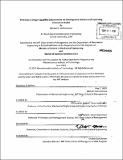Preliminary design capability enhancement via development of rotorcraft operating economics model
Author(s)
Giansiracusa, Michael P
DownloadFull printable version (15.93Mb)
Other Contributors
Leaders for Global Operations Program.
Advisor
Christopher Magee and Roy Welsch.
Terms of use
Metadata
Show full item recordAbstract
The purpose of this thesis is to develop a means of predicting direct operating cost (DOC) for new commercial rotorcraft early in the design process. This project leverages historical efforts to model operating costs in the aviation industry coupled with a physics-based approach. The physics governing rotorcraft operation are combined with fundamental considerations encountered during rotorcraft design to identify potential design parameters driving operating costs. Sources for obtaining data on these parameters for existing designs are explored. The response data is generated by estimating operating costs for seventy-seven currently available commercial rotorcraft models under a fixed set of operating assumptions. Statistical analysis of this data is combined with the physics and first principles approach to identify key explanatory variables demonstrating a strong relationship to operating cost. Multiple regression techniques are used to develop transfer functions relating rotorcraft design variables to direct operating cost. The analysis shows that the maximum takeoff gross weight of the rotorcraft design is strongly correlated with direct operating costs. Specifically, a simple regression model using the square root of maximum takeoff gross weight as the only explanatory variable can be used to account for over 90 percent of the variation in total direct operating cost (TDOC). After accounting for maximum takeoff gross weight, the analysis suggests that rotorcraft models with two engines have higher TDOC than those with a single engine. A multiple regression model using maximum takeoff gross weight and the number of installed engines in the rotorcraft design is presented and accounts for 97 percent of the variation in TDOC. This model allows designers to quickly estimate TDOC for new rotorcraft early in the design process, before many of the major design parameters have been finalized. In addition to the aggregate or total DOC models, regression models for a few key subcategories of DOC are developed including, fuel related DOC, airframe maintenance related DOC and engine maintenance related DOC. In the case of fuel related and airframe maintenance related DOC, the maximum takeoff gross weight is found to be the single strongest explanatory variable. For the engine maintenance DOC, the engine weight is found to be the single variable most strongly correlated with operating cost. We conclude that an appropriate measure of weight (maximum takeoff gross weight or engine weight) is an important driver for direct operating cost. After accounting for weight, the models are refined by considering additional explanatory variables leading to models of greater accuracy and complexity. The modular nature of the model presented allows operating cost estimates to be improved and refined as additional details of the rotorcraft design become available during the design process.
Description
Thesis (S.M.)--Massachusetts Institute of Technology, Dept. of Mechanical Engineering; and, (M.B.A.)--Massachusetts Institute of Technology, Sloan School of Management; in conjunction with the Leaders for Global Operations Program at MIT, 2010. Page numbers proceeded by chapter numbers. Cataloged from PDF version of thesis. Includes bibliographical references (p. 107-111).
Date issued
2010Department
Leaders for Global Operations Program at MIT; Massachusetts Institute of Technology. Department of Mechanical Engineering; Sloan School of ManagementPublisher
Massachusetts Institute of Technology
Keywords
Mechanical Engineering., Sloan School of Management., Leaders for Global Operations Program.